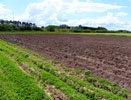Services
Solutions
Fulltext
Guyana (2006-2008)
Works were implemented in Guyana in accordance with the development aid project entitled "Mining and processing of industrial minerals in Jamaica and in selected CARICOM States" (2006-2011). The scope of this work was based on the development objectives and priorities of the Guyana side, represented by the Guyana Geology and Mines Commission (GGMC). Colleagues from the partner organisation participated in the selection of the sites and in the professional and the logistical implementation of the geological reconnaissance works.
 Guyana is the largest of the CARICOM States; the majority of its land-surface is covered by tropical forest. Primarily mined are bauxite and gold, while hopes are placed on the exploration for oil along the coast. The main objective of our work was the geological and technological evaluation of potential sources of selected non-metallic mineral resources with a focus on kaolin, quartz and feldspar sands and gravel. Prospecting and geological reconnaissance work and sampling were carried out in the locations of kaolin in the Ituni area and at the Topira, Kamakabra and Warababaru deposits, the locations of quartz sand along the Georgetown - Linden road and in the area of Bartico, of decorative stone (gabbro) at the Arisara site, of crushed stone in the Big Hope, Monkey Jump, St. Mary and B. K. quarries near Bartico and of feldspar sands at the Flat Rock site. Rock samples were collected from artificial or natural outcrops, exploration cuts and shallow boreholes. Laboratory, technological, mineralogical-petrological and geological evaluations were carried out in the Czech Republic.
Guyana is the largest of the CARICOM States; the majority of its land-surface is covered by tropical forest. Primarily mined are bauxite and gold, while hopes are placed on the exploration for oil along the coast. The main objective of our work was the geological and technological evaluation of potential sources of selected non-metallic mineral resources with a focus on kaolin, quartz and feldspar sands and gravel. Prospecting and geological reconnaissance work and sampling were carried out in the locations of kaolin in the Ituni area and at the Topira, Kamakabra and Warababaru deposits, the locations of quartz sand along the Georgetown - Linden road and in the area of Bartico, of decorative stone (gabbro) at the Arisara site, of crushed stone in the Big Hope, Monkey Jump, St. Mary and B. K. quarries near Bartico and of feldspar sands at the Flat Rock site. Rock samples were collected from artificial or natural outcrops, exploration cuts and shallow boreholes. Laboratory, technological, mineralogical-petrological and geological evaluations were carried out in the Czech Republic.
Very interesting results were obtained from the exploration for kaolin. Deposits of this mineral are found in areas of the former mining of bauxite, in which, in the excavated areas, heads of kaolinitic eluvia of Precambrian granites or fluvial relocated kaolinitic clays were exposed. Utilising a hand-held Eijkelkamp rig, a number of exploratory boreholes with a depth range of 4-5 m were excavated there as part of the project. These works also included surveying the terrain, significantly furrowed by bauxite mining, and the processing of general mining maps of the individual deposits. It was confirmed that this is a very high-quality kaolin, suitable for conventional methods of use (paper kaolin, kaolin for the production of fine ceramics), and also for new applications, for example for the production of metakaolin and of white grog. It is clear that this positive development effectively supersedes the former mining of bauxite and that the thickness of the positive development exceeds the depth range of shallow boreholes and may be in the order of tens of metres. These assumptions can be verified during the next phase of exploration by using a core-drilling machine, the implementation of which will be dependent on a potential investor. A high quality material for the production of crushed stone was verified at the sites surveyed, in some cases also suitable for block extraction.
The assessment of individual sites also included the evaluation of their accessibility and of conflicts of interest in regard to nature conservation.
Significantly contributing to the project were the foremost laboratories and institutions of the Czech Republic; specifically the Institute of Geology of the AS CR, the Institute of Chemical Technology, Prague; the Testing Laboratory of Stone and Aggregates, Hořice; KERAMEX Group s.r.o, Karlovy Vary; GEOMEDIA, s.r.o., Prague; GEMATEST spol. s r.o., Černošice; GIS-GEOINDUSTRY s.r.o., Prague; the Central Laboratory of the Sedlecký kaolin, a.s. Company, Božičany and the Laboratory of České lupkové závody, a.s., Nové Strašecí.































